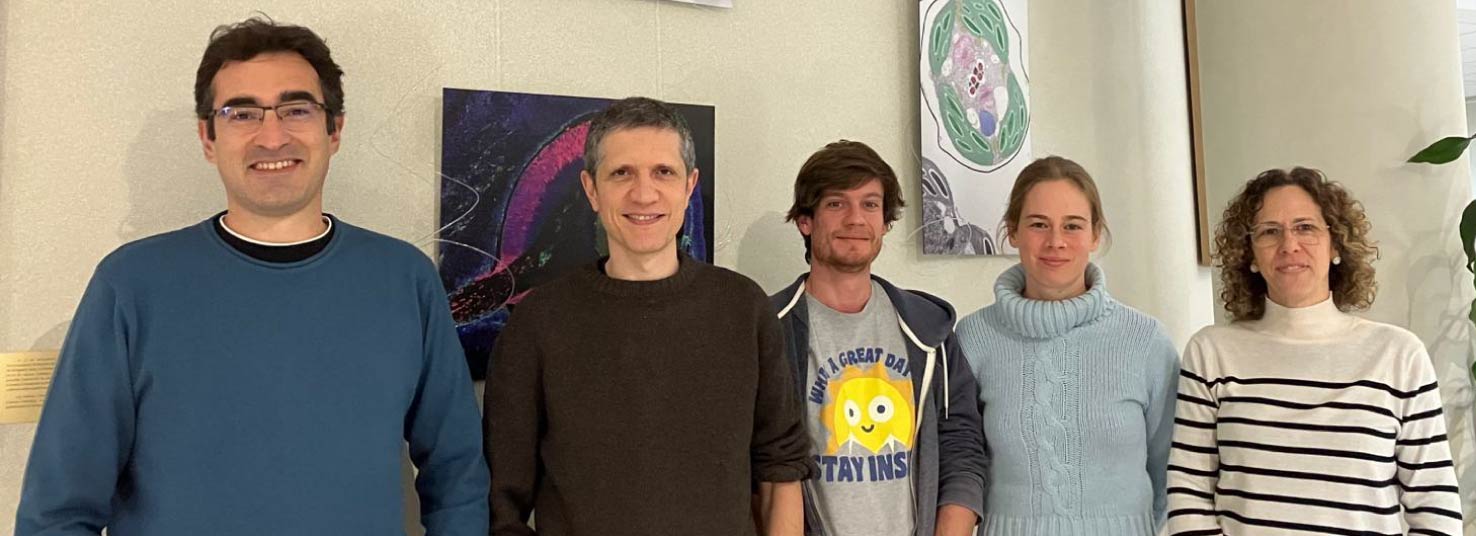Group Leader/s
intro
Our group aims to unveil the structure of cellular machines to gain mechanistic insight into macromolecular function and assist the development of biomedical applications. For this, we use electron cryomicroscopy (cryo-EM) and X-ray crystallography, both providing information to atomic resolution, combined with other biophysical and biochemical techniques. This integrative methodology is applied to study essential cell processes such as genome transcription, DNA repair, DNA integration and cell division.

Genome transcription
The transfer of genetic information encoded in DNA is the main determinant of gene expression. Alterations in this process have significant impact on cell homeostasis and are directly related to disease. RNA polymerases transcribe the genetic information from DNA to RNA, by catalyzing the addition of nucleotides that are complementary to the DNA template strand. Eukaryotes require three different RNA polymerases, each transcribing a specific set of genes. We focus on the study of RNA polymerase I and various transcription factors that regulate gene expression. Further details can be found [here].

DNA damage detection and repair
DNA damage threatens cell life and must be repaired to maintain genome integrity. Transcription is particularly sensitive to DNA damage and, hence, it is linked to DNA repair. Different lesions induce RNA polymerase stalling, which activates the recruitment of DNA repair factors, including endonucleases XPF and XPG to eliminate the lesion. Alterations in these repair factors associate with genetic disorders such as xeroderma pigmentosum and Cockayne syndrome. We focus on the study of lesion detection by RNA polymerases and damaged DNA elimination by XPG. Further details can be found [here].

Directed DNA integration
Transposable elements are DNA sequences that can change their position within genomes. Their movement drives the development of new cellular functions, but it can also produce harmful mutations. To minimize deleterious effects, retrotransposons insert into safe regions of the genome through tethering of their integrase to proteins operating on the chromatin, such as RNA polymerases. Further details can be found [here].

Bacterial cell division
Cell division is an essential biological process that enables propagation of living organisms. Bacterial division involves protein assembly into the divisome, which coordinates membrane invagination and synthesis of the cell wall, finally giving rise to two daughter cells. As such, bacterial cell division proteins are targets for the discovery of new antibiotics, which are needed to fight resistant bacterial pathogens. We focus on the study of FtsZ, an ancestral tubulin homologue playing a central role in bacterial cell division. Further details can be found [here].

Members
| Carlos Fernández Tornero |
| Sonia Huecas Gayo |
| Federico Martin Ruiz |
| Tommy Pascal Darriere |
| alicia Santos Gonzalez de Aledo |
| Jimena Fornas de la Rosa |

Funding
2021-2024. PID2020-116722GB-I00. Spanish Ministry of Science [PI]
2022-2024. Industrial R&D Project with PharmaMar [PI]
2018-2021. BFU2017-87397-P. Spanish Ministry of Science [PI]
2020-2021. 2020AEP152. Spanish National Research Council (CSIC) [PI]
2015-2018. Ramón Areces Foundation [PI]
2014-2017. BFU2013-48374-P. Spanish Ministry of Science [PI]
2011-2013. BFU2010-16336. Spanish Ministry of Science [PI]
2010-2012. EIC-EMBL-2011-0076. Spanish Ministry of Science [PI]
2010-2011. 200920I077. Spanish National Research Council (CSIC) [PI]
2018-2022. Agence Nationale de la Recherche (France). [Team leader]
2021-2022. EQC2021-006930-P. Spanish Ministry of Science [Team leader]
2020-2022. RED2018-102467-T. Spanish Ministry of Science [Team leader]
2016-2017. BFU2015-71978-REDT. Spanish Ministry of Science [Team leader]
2014-2015. CSIC13-4E-1700. Spanish Ministry of Science [Team leader]
2011-2018. Industrial R&D Project with PharmaMar [PI]
More info
Outreach publications
Fernández-Tornero C. (2021) Hibernación molecular. Article & interview in SEBBM Section 'Nuestros Científicos'
Fernández-Tornero C. (2017) Dime con quién andan tus proteínas y te diré qué hacen tus células. Huffington Post – 21 March
Fernández-Tornero C. (2013) Viaje al centro de la célula. Huffington Post – 31 October (Front page)
Fernández-Tornero C. (2014) La síntesis del ARN: un proceso en el centro de la vida. Boletín de la Institución Libre de Enseñanza 95-96:77-87
Fernandez-Tornero C. (2010) Nobel Prize in Chemistry 2009: atomic structure of the cellular machinery for protein synthesis. Anales de la Real Academia Nacional de Farmacia 76:119-136
Selected highlights from the media
http://www3.radioecca.org/radio/carta/lo-nuestro/84790552
https://www.larazon.es/sociedad/20220323/zstidhycwvgadduj2vz7tcwnam.html
https://www.efe.com/efe/espana/efefuturo/-/50000905-3725429
https://www.sciencedaily.com/releases/2018/08/180822164205.htm
Networks
LifeHUB Network [Team Leader]
RNA Life Network [Team leader]
Alumni
Srdja Drakulic, Postdoc (2017-2019)
Mercedes Spínola-Amilibia, Postdoc (2017)
Rocío González-Corrochano, Postdoc (2011-2016)
Eva Torreira, Postdoc (2011-2016)
Nicholas M. I. Taylor, Postdoc (2011-2012)
Adrián Plaza-Pegueroles, PhD Student (2019-2024)
Phong Q. Nguyen, PhD Student (2019-2022)
Marta Sanz-Murillo, PhD Student (2014-2019)
Jaime A. Louro, PhD Student (2011-2016)
Jimena Fornás de la Rosa (2023)
Héctor Leal Lasalle (2022)
Carolina Muñoz Núñez (2021)
Erica González Castro (2020)
Carla Gracia Paricio (2020)
Alicia Santos González de Aledo (2018-2019)
Álvaro Ras Carmona (2018)
Carolina Correa Maté (2017-2018)
Carlos Pardo Hernández (2017)
Álvaro de la Gándara (2017)
Paula García Trapote (2015-2016)
Nuria Castillo Tutor (2011-2015)
Pablo Saralegui (2011)
Marcel Rösinger (2010-2011)

